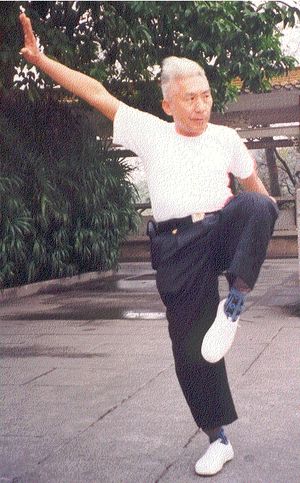Single Leg Stance Test: Difference between revisions
No edit summary |
No edit summary |
||
| Line 5: | Line 5: | ||
</div> | </div> | ||
== Purpose == | == Purpose == | ||
The Single leg Stance (SLS) Test is used to assess static [[Posture|postural]] and [[balance]] control. | * [[File:Single Leg Stance posture (1).jpg|right|frameless]]The Single leg Stance (SLS) Test is used to assess static [[Posture|postural]] and [[balance]] control. | ||
* Balance assessments (like SLS test) are a valuable clinical tool for monitoring [[Neurological Disorders|neurological]] and musculoskeletal status as well as for managing [[Falls|fall]] risk<ref name=":0">Zhang C, Talaber A, Truong M, Vargas BB. [https://www.ncbi.nlm.nih.gov/pmc/articles/PMC6831964/ KD Balance: An objective measure of balance in tandem and double leg stances.] Digital Health. 2019 Oct;5:2055207619885573.Available from:https://www.ncbi.nlm.nih.gov/pmc/articles/PMC6831964/ (accessed 13.12.2020)</ref>. | |||
Balance assessments (like SLS test) are a valuable clinical tool for monitoring [[Neurological Disorders|neurological]] and musculoskeletal status as well as for managing [[Falls|fall]] risk<ref name=":0">Zhang C, Talaber A, Truong M, Vargas BB. [https://www.ncbi.nlm.nih.gov/pmc/articles/PMC6831964/ KD Balance: An objective measure of balance in tandem and double leg stances.] Digital Health. 2019 Oct;5:2055207619885573.Available from:https://www.ncbi.nlm.nih.gov/pmc/articles/PMC6831964/ (accessed 13.12.2020)</ref>. | Image: SLS by a famous Tai Chi master | ||
== Method == | == Method == | ||
Performed with eyes open and hands on the hips. | * Performed with eyes open and hands on the hips. | ||
* Client must stand unassisted on one leg, timed from the time the other foot leaves the ground till when the foot touches the ground again or the arms leave the hips. | |||
Client must stand unassisted on one leg, timed from the time the other foot leaves the ground till when the foot touches the ground again or the arms leave the hips. | * If unable to stand for 5 seconds or less client at greater risk of injury from [[Falls Risk Assessment Tool (FRAT): An Overview to Assist Understanding and Conduction|fall]].<ref>Abilitiy lab [https://www.sralab.org/rehabilitation-measures/single-leg-stance-or-one-legged-stance-test SLS] Available from:https://www.sralab.org/rehabilitation-measures/single-leg-stance-or-one-legged-stance-test (last accessed 13.12.2020)</ref> | ||
If unable to stand for 5 seconds or less client at greater risk of injury from fall.<ref>Abilitiy lab [https://www.sralab.org/rehabilitation-measures/single-leg-stance-or-one-legged-stance-test SLS] Available from:https://www.sralab.org/rehabilitation-measures/single-leg-stance-or-one-legged-stance-test (last accessed 13.12.2020)</ref> | |||
== Clinical Implications == | == Clinical Implications == | ||
| Line 22: | Line 20: | ||
* [[Traumatic Brain Injury|Traumatic brain injury]] | * [[Traumatic Brain Injury|Traumatic brain injury]] | ||
* General [[Older People - An Introduction|geriatric]] population | * General [[Older People - An Introduction|geriatric]] population | ||
* Lower extremity pathology like [[Knee Osteoarthritis|knee osteoarthritis]] (OA), one of the most common chronic health conditions, is associated with significant impairment and disability, and predominantly affects the elderly population<ref>Hunt MA, McManus FJ, Hinman RS, Bennell KL. [https://onlinelibrary.wiley.com/doi/full/10.1002/acr.20046 Predictors of single‐leg standing balance in individuals with medial knee osteoarthritis]. Arthritis care & research. 2010 Apr;62(4):496-500. Available from:https://onlinelibrary.wiley.com/doi/full/10.1002/acr.20046 (accessed 13.12.2020)</ref> | * Lower extremity pathology like [[Knee Osteoarthritis|knee osteoarthritis]] (OA), one of the most common [[Chronic Disease|chronic health conditions]], is associated with significant impairment and disability, and predominantly affects the elderly population<ref>Hunt MA, McManus FJ, Hinman RS, Bennell KL. [https://onlinelibrary.wiley.com/doi/full/10.1002/acr.20046 Predictors of single‐leg standing balance in individuals with medial knee osteoarthritis]. Arthritis care & research. 2010 Apr;62(4):496-500. Available from:https://onlinelibrary.wiley.com/doi/full/10.1002/acr.20046 (accessed 13.12.2020)</ref><ref name=":0" /><ref>Bonora G, Mancini M, Carpinella I, Chiari L, Ferrarin M, Nutt JG, Horak FB. Investigation of anticipatory postural adjustments during one-leg stance using inertial sensors: evidence from subjects with Parkinsonism. Frontiers in neurology. 2017 Jul 25;8:361.Available from:https://www.frontiersin.org/articles/10.3389/fneur.2017.00361/full (accessed 13.12.2020)</ref>. | ||
== References == | == References == | ||
Revision as of 07:25, 13 December 2020
Original Editor - Lucinda hampton
Top Contributors - Lucinda hampton, Clara Foster, Christine Ibeagi, Jessyca Brown, Aminat Abolade, Kim Jackson and Wanda van Niekerk
Purpose[edit | edit source]
- The Single leg Stance (SLS) Test is used to assess static postural and balance control.
- Balance assessments (like SLS test) are a valuable clinical tool for monitoring neurological and musculoskeletal status as well as for managing fall risk[1].
Image: SLS by a famous Tai Chi master
Method[edit | edit source]
- Performed with eyes open and hands on the hips.
- Client must stand unassisted on one leg, timed from the time the other foot leaves the ground till when the foot touches the ground again or the arms leave the hips.
- If unable to stand for 5 seconds or less client at greater risk of injury from fall.[2]
Clinical Implications[edit | edit source]
Ability to control anticipatory postural adjustments (APAs) prior to lifting one leg while standing in unsupported equilibrium represents a complex motor task that is significantly impaired by eg
- Neurological conditions like multiple sclerosis, Parkinson’s disease, Alzheimer’s disease, and dementia
- Stroke
- Traumatic brain injury
- General geriatric population
- Lower extremity pathology like knee osteoarthritis (OA), one of the most common chronic health conditions, is associated with significant impairment and disability, and predominantly affects the elderly population[3][1][4].
References[edit | edit source]
- ↑ 1.0 1.1 Zhang C, Talaber A, Truong M, Vargas BB. KD Balance: An objective measure of balance in tandem and double leg stances. Digital Health. 2019 Oct;5:2055207619885573.Available from:https://www.ncbi.nlm.nih.gov/pmc/articles/PMC6831964/ (accessed 13.12.2020)
- ↑ Abilitiy lab SLS Available from:https://www.sralab.org/rehabilitation-measures/single-leg-stance-or-one-legged-stance-test (last accessed 13.12.2020)
- ↑ Hunt MA, McManus FJ, Hinman RS, Bennell KL. Predictors of single‐leg standing balance in individuals with medial knee osteoarthritis. Arthritis care & research. 2010 Apr;62(4):496-500. Available from:https://onlinelibrary.wiley.com/doi/full/10.1002/acr.20046 (accessed 13.12.2020)
- ↑ Bonora G, Mancini M, Carpinella I, Chiari L, Ferrarin M, Nutt JG, Horak FB. Investigation of anticipatory postural adjustments during one-leg stance using inertial sensors: evidence from subjects with Parkinsonism. Frontiers in neurology. 2017 Jul 25;8:361.Available from:https://www.frontiersin.org/articles/10.3389/fneur.2017.00361/full (accessed 13.12.2020)







